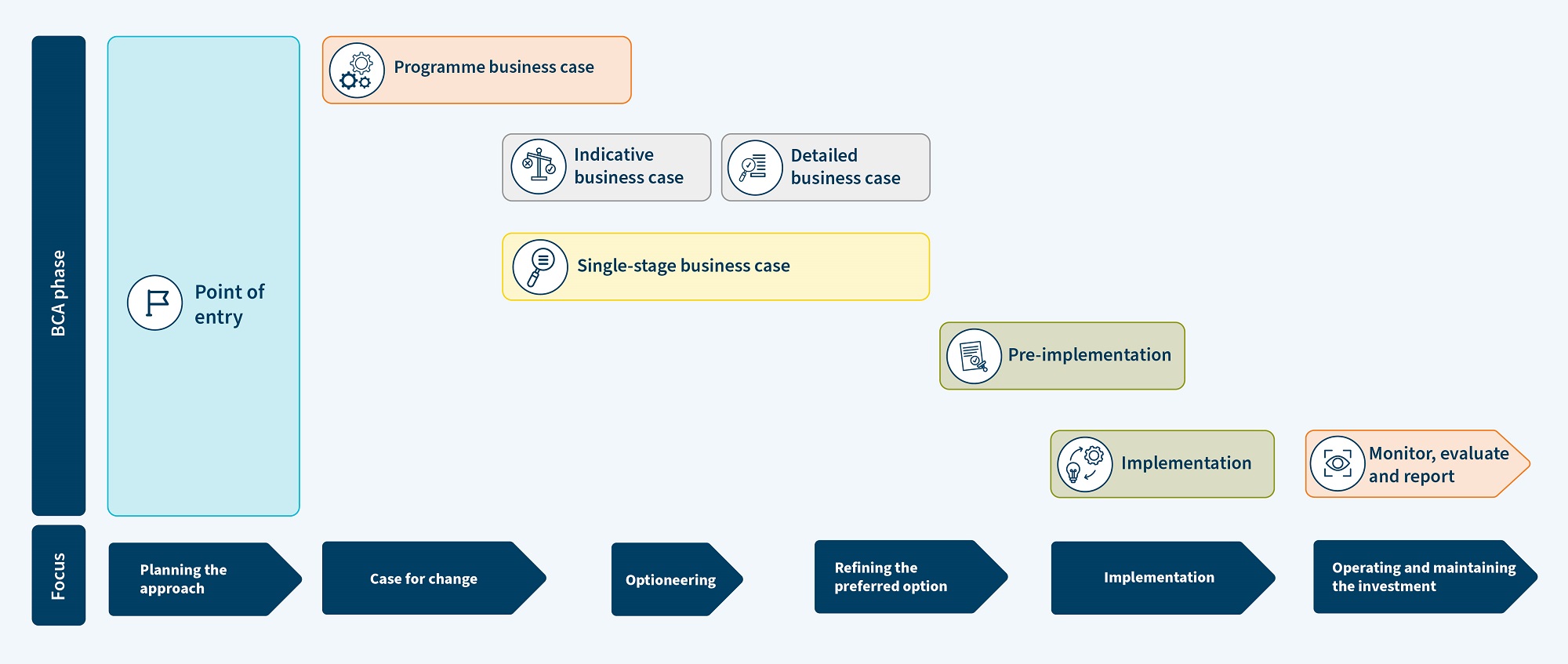 The single-stage business case (SSBC) merges the key actions from the indicative business case (IBC) and the detailed analysis of the detailed business case (DBC) into one phase.
The single-stage business case (SSBC) merges the key actions from the indicative business case (IBC) and the detailed analysis of the detailed business case (DBC) into one phase.
Indicative business case phase
Detailed business case phase
A key principle of the Business Case Approach (BCA) is fit-for-purpose effort, and the SSBC and SSBC-lite provide ways to develop your business case appropriate to the level of complexity, risk, uncertainty and cost. In these cases, a single NLTP funding decision will be made by Waka Kotahi to enable the activity level business case to be developed.
The SSBC is, along with the IBC and DBC, focuses on an activity/set of activities rather than a multi-outcome programme. The diagram below shows where the SSBC phase fits within the framework of business case development pathways.

View larger image [JPG, 218 KB]
Guidance for Waka Kotahi business cases is based on New Zealand Treasury’s Better Business Cases five-case model.
The table below shows that all of the five cases are completed in the SSBC.
| Strategic case What is the compelling case for change? |
Economic case Does the preferred option optimise value for money? |
Commercial case Is the proposed deal commercially viable? |
Financial case Is the investment proposal affordable? |
Management case How can the proposal be delivered successfully? |
|---|---|---|---|---|
 |
|
|
|
|
| Develop or refine and confirm |
Develop or refine and confirm |
Develop and confirm |
Develop and confirm |
Develop and confirm |
From a five-case model perspective, the first part of the SSBC follows the key steps of IBC in that it focuses on confirming the strategic case (the case for change) and the economic case (optioneering), with the aim of indicating a recommended option. You should have an internal hold point to ensure that key decision makers are onboard with the recommended option before investing too much effort into developing to detail through the commercial, financial and management cases – the part of the SSBC that mirrors the DBC. If you have completed a related programme business case (PBC) you may already have work related to all the cases to revisit.
Note that all five cases will need to be completed to a level of detail appropriate for the investment, whether you are using either the SSBC or IBC + DBC pathways. For more information about each case in the five-case model, see our detailed guidance.
Business Case Approach principles
The SSBC needs to follow the key BCA principles of investing for benefits, fit-for-purpose effort, clarity of intent, progressive development and informed discussion.
The table below shows how the SSBC mirrors the requirements of the IBC and DBC. However, some key differences include:
| Low- to medium- risk and/or complexity proposals | High-risk and/or high-complexity proposals | Summary of requirements |
|---|---|---|
|
Single-stage business case |
The purpose of IBC is to provide decision makers with early indication of the recommended option (activity level) by:
|
|
|
Internal hold point |
Investment decision gate |
A decision gate is required for high risk and/or high complexity activities (those that are following an IBC + DBC pathway). For an SSBC, a hold point should be used internally to ensure that key stakeholders are on board with the recommended option. It is good practice for the problem owner check in with their Waka Kotahi Investment advisor on the progress to date as well as using the Investment Prioritisation Method (IPM) to check alignment with the Government Policy Statement on Land Transport (GPS) and receive an investment signal from Waka Kotahi. The problem owner should also complete a self-assessment of the progress to date. |
|
|
The main purpose of the DBC is to provide assurance that the preferred option identified in the IBC is the right approach to deliver the desired outcomes and is an effective solution to the identified problems. This is done by:
For more information on what is expected from a DBC, see our guidance page. |
When preparing to undertake an activity-level business case, you need to think through the levels of cost, risk, and complexity to determine whether:
You can use our guidance on determining the pathway through BCA phases and the BCA Q&A tool to guide your critical thinking about the phase of the BCA you should progress to next.
Determining your pathway through the business case phases
Business Case Approach Q&A tool
Your Waka Kotahi investment advisor will be able to provide advice around which pathway is most appropriate for your investment. Pathway discussions usually form a key part of point of entry (PoE) discussions.
Waka Kotahi expects that, where risk levels show it is appropriate, most activities seeking National Land Transport Programme (NLTP) investment will follow the SSBC path. This follows the principle of fit-for-purpose effort to help keep development times and costs to a minimum.
However, an SSBC is only appropriate where there a lower level of risk, complexity, risk, uncertainty and cost. For higher risk and complexity activities, an IBC + DBC pathway will be more appropriate.
Where the investment is straightforward, you can consider an SSBC-lite approach (see below).
Note that all five cases will need to be completed to a fit-for-purpose level of detail for both the IBC + DBC and SSBC pathways. The key difference is the opportunity to formally involve decision makers at the recommended option stage. Therefore, an SSBC should only be considered for straightforward and low-risk investments.
SSBC-lite
For straightforward investments meeting specific criteria, a SSBC-lite may be an appropriate option. The following criteria must be met:
Talk to your investment advisor to ensure that an SSBC-lite is appropriate for your investment.
A template is available to help you complete your SSBC-lite.
For detailed guidance on what needs to go into your SSBC, see our guidance on the IBC and DBC.
Indicative business case phase
Detailed business case phase
An information guide is available as an option for you to use and adapt when writing your SSBC document, to help you tell your investment story.
Single-stage business case document information guide [DOCX, 1.2 MB]
The SSBC document should:
Consider creating an A3 summary page that tells your investment story graphically and succinctly.
Send the SSBC document to all participant stakeholders for comment before submitting it to Waka Kotahi for assessment. If there are co-investors, you will need to seek their support, which will likely involve going through their internal approval processes. The decision-making needs of each co-investor must be clear in the project plan and governance section of the SSBC document.
Before approaching Waka Kotahi for a formal assessment of your business case, you should make a self-assessment to check the document is ready.
How you answer this will depend on how complex the investment is, and how much risk or uncertainty is involved.
There are a few things that can help you answer this question, including:
How to self-assess your business case
When assessing applications to fund business case phases from the National Land Transport Fund (NLTF), Waka Kotahi will seek assurance that the strategic case has been adequately developed.
As a principles-based approach, there is no checklist of specific actions to follow to ensure that Waka Kotahi’s expectations regarding the DBC phase are being met. However, when assessing funding applications for subsequent business case phases, there are some general questions that assessors will consider to ensure that the principles relating to the strategic case are being followed, including:
If you are seeking NLTP funding, you must submit a robust funding application for implementation in Transport Investment Online (TIO) (or via your investment advisor for Waka Kotahi projects), with the SSBC uploaded as the supporting document. A clear understanding of the funding requirements for the next phase is needed. A pre-implementation phase will likely be required to undertake further work on risk management, consenting, costing, etc.
Transport Investment Online(external link)
When the request for SSBC support and funding approval is received in TIO, Waka Kotahi assesses the business case against the business case assessment questions and the criteria set out in the Investment Prioritisation Method (IPM) to determine whether:
A recommendation is then made to the delegated decision maker to support the SSBC or otherwise. . If your Waka Kotahi investment advisor has been involved throughout development of the business case, there shouldn’t be any surprises that result from the decision.
Make sure you communicate with key stakeholders about the reason for the decision. Consider holding a report-back session for all stakeholders, especially if you planned for one in your engagement plan.
Contact your Waka Kotahi investment advisor or email the Business Case Process team at businesscaseprocess@nzta.govt.nz